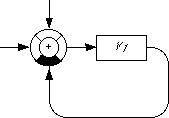|
Principles of the Method
A cybernetic Model of Pituitary-Thyroid Feedback Control allows for calculating constant transfer parameters of the information processing structure from hormone levels determined in vivo. Currently two variables can be calculated: 1. The thyroid's T4-secrection capacity (SPINA-GT) is determined with
from values for TSH, FT4 and plasma proteins. Measuring total thyroxine instead of free T4 this expression can be simplified to
From the results of a study with healthy volunteers a preliminary reference region for GT followes as 1,41 - 8,67 pmol/sec. 2. In a similar way the sum activity of peripheral 5'-deiodinases (SPINA-GD) can be calculated with
from FT3-, FT4- and TBG-levels or with
from FT4- and total T3-level, respectively. The preliminary reference region for GD is 20,4 - 39,4 nmol/sec. In order to deliver meaningful calculation results it should be ensured that the system is in state of equilibrium and the patient uses no substitution therapy with thyroid hormones.
The following constants are required by the equations:
With the exception of thyrotropin (TSH) that is specified as mU/l all hormone levels are assumed to be in mol/l and have first to be converted, where necessary. The Calculation programs on this site can execute these conversions automatically. ReferencesDietrich, J. W., U. Mitzdorf, R. Weitkunat and C. R. Pickardt (1997). "The pituitary-thyroid feedback control: stability and oscillations in a new nonlinear model." Journal of Endocrinological Investigation 20 (Suppl. to no. 5): 100. Dietrich, J., M. Fischer, J. Jauch, E. Pantke, R. Gärtner and C. R. Pickardt (1999). "SPINA-THYR: A Novel Systems Theoretic Approach to Determine the Secretion Capacity of the Thyroid Gland." European Jounal of Internal Medicine 10, Suppl. 1 (5/1999): S34. Dietrich, J. W., A. Tesche, C. R. Pickardt and U. Mitzdorf (2002). Fractal Properties of the Thyrotropic Feedback Control: Implications of a Nonlinear Model Compared with Empirical Data. In: Cybernetics and Systems 2002. R. Trappl (Hrsg). Vienna. Dietrich, J. W. (2002). Der Hypophysen-Schilddrüsen-Regelkreis. Entwicklung und klinische Anwendung eines nichtlinearen Modells. Berlin, Logos-Verlag. Dietrich, J. W., A. Tesche, C. R. Pickardt and U. Mitzdorf (2004). "Thyrotropic Feedback Control: Evidence for an Additional Ultrashort Feedback Loop from Fractal Analysis." Cybernetics and Systems 35 (4): 315-31. Dietrich, J. W. und B. O. Boehm (2006). Equilibrium behaviour of feedback-coupled physiological saturation kinetics. In: Cybernetics and Systems 2006. R. Trappl (Hrsg). Vienna, Austrian Society for Cybernetic Studies. 1: 269-74. Dietrich JW, Stachon A, Antic B, Klein HH, Hering S (2008). The AQUA-FONTIS Study: Protocol of a multidisciplinary, cross-sectional and prospective longitudinal study for developing standardized diagnostics and classification of non-thyroidal illness syndrome. BMC Endocr Disord. 13;8(1):13. Dietrich, J. W., G. Landgrafe, E. H. Fotiadou (2012). TSH and thyrotropic agonists: Key actors in thyroid homeostasis. Journal of Thyroid Research, vol. 2012, Article ID 351864, 29 pages, 2012. PMID 23365787, doi:10.1155/2012/351864.
|
|||||||||||||||||||||||||||||||||||||||||||||||||||||||||||||||||||||||||||||||||||
|
|
||||||||||||||||||||||||||||||||||||||||||||||||||||||||||||||||||||||||||||||||||||
|
© 1997-2012 J. W. Dietrich (Ideas, Conception and Development) |
||||||||||||||||||||||||||||||||||||||||||||||||||||||||||||||||||||||||||||||||||||

